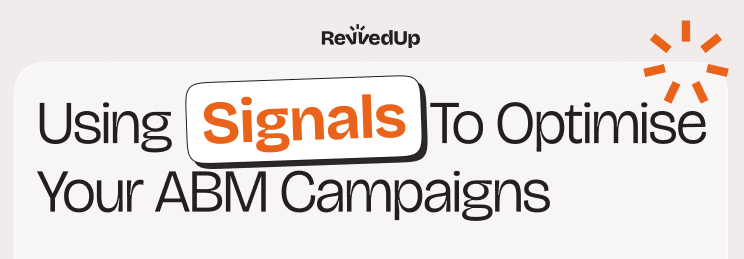Using Signals to Optimise Your ABM Campaigns: Six Key Insights

If your outreach isn’t getting traction, the issue might not be what you’re saying—it could be who you're trying to reach, and when.
In our recent webinar, Mark Walker (RevvedUp), Alan Ruchtein (Modern Seller Program), and Max Mitcham (Trigify) explored how signals, triggers, and intent data can help you engage prospects at the right moment.
1. Know the Difference: Signals, Intent & Triggers
It might feel like these terms blend together, but knowing the distinctions helps you target the right people at the right time.
- Signals are general behaviours showing they might have the challenge or goal you can help solve (e.g. fundraising event, new hires, new in role).
- Intent signals indicate buying readiness (e.g. researching competitors, multiple website visits, content downloads).
- Triggers are the tipping point where you stack signals and intent together to reach a threshold which 'triggers' you to reach out (e.g. A company has announced their funding, and they've engaged with a competitors post and visited your website).
📌 Webinar Takeaway: Max highlighted that a signal is just an insight - it does not mean a prospect is ready to buy. Triggers, however, are stacked signals that indicate now is the time to reach out. Understanding this difference ensures you do not waste outreach efforts on weak signals.
2. Combine Company-Level & Contact-Level Signals
Max suggests starting with company-wide signals before diving into contact-level details:
- Company-level signals: Fresh funding, leadership changes, rapid hiring.
- Contact-level signals: Engagement with your competitor’s content, LinkedIn profile views, repeat visits to your pricing page.
📌 Webinar Takeaway: Max explained how Trigify tracks hidden social signals to detect when a contact is actively engaging with relevant industry topics, making it easier to reach them at the right time.
Alan arrives at the same outcome, but going the opposite route. He recommends team to start with contact level engagement; but then layer in company-level signals to ensure that the overall account is well aligned to your ICP.
3. Use Explicit or Implicit Messaging
Alan talked through two outreach styles:
- Explicit: Reference their behaviour directly (e.g. “I saw you signed up for our report - what stood out?”).
- Implicit: Offer value without mentioning the underlying signal (e.g. “Many new VPs of Sales struggle with their first 90 days - here is a quick guide.”).
📌 Webinar Takeaway: Alan emphasised that implicit messaging often works better for high-level executives, as they may find direct references to tracking too invasive. Providing useful resources upfront helps establish credibility before moving to direct sales conversations.
And Max doubled down on this, sharing if there was one thing to take away from the webinar is to avoid explicitly referencing signals!
4. Bottom-Up Works Too
Rather than going straight to the C-suite, Mark suggests starting with lower or mid-level stakeholders (splitting 'Below The Line - BTL' with 'Above The Line - ATL') approaches:
- Those 'BTL' often share valuable insights about internal goals and pain points.
- Build credibility from the ground up before approaching decision-makers.
📌 Webinar Takeaway: Max pointed out that many SDR teams get fixated on reaching the C-suite too soon. Instead, gaining insights from mid-level contacts can make your pitch stronger when you eventually reach decision-makers.
5. Track Competitors & Industry News
Staying on top of competitor moves and industry changes can be an easy icebreaker for outreach.
- Mention relevant news in your outreach: “Did you see the latest update from [Competitor]? It might impact your strategy - thoughts?”
- Use these events to frame your solution as timely and relevant.
📌 Webinar Takeaway: Mark advised using AI and real-time industry monitoring tools (a feature of RevvedUp) to track competitor activity. Mentioning a competitor’s behaviours in outreach adds instant relevance and increases response rates.
6. ABM can be scaled
The whole panel agreed that the concept of ABM as an expensive, enterprise only strategy is old news. In 2025, the core principles can be scaled to reach every account.
- Based your outreach on deep insights and reach...but let AI and agents do the hard work for you
- Make sure your messaging is on-point, and shared across multiple panels to cut through
📌 Webinar Takeaway: Mark stressed that AI is not there to replace whole roles; but it can make them 100x more efficient than in the past, allowing you to increase your reach without a corresponding increase in time or cost.
Final Thoughts
Signals and triggers will not sell your product for you, but they will point you toward the right conversations.
By:
- Paying attention to real behaviours.
- Weaving insights into outreach naturally.
- Timing your messages strategically.
Your ABM efforts will shift from generic blasts to meaningful, high-impact interactions.
Try out these six strategies and see how they improve your pipeline.
Want to see how RevvedUp can help you use signals? Talk to our team.
